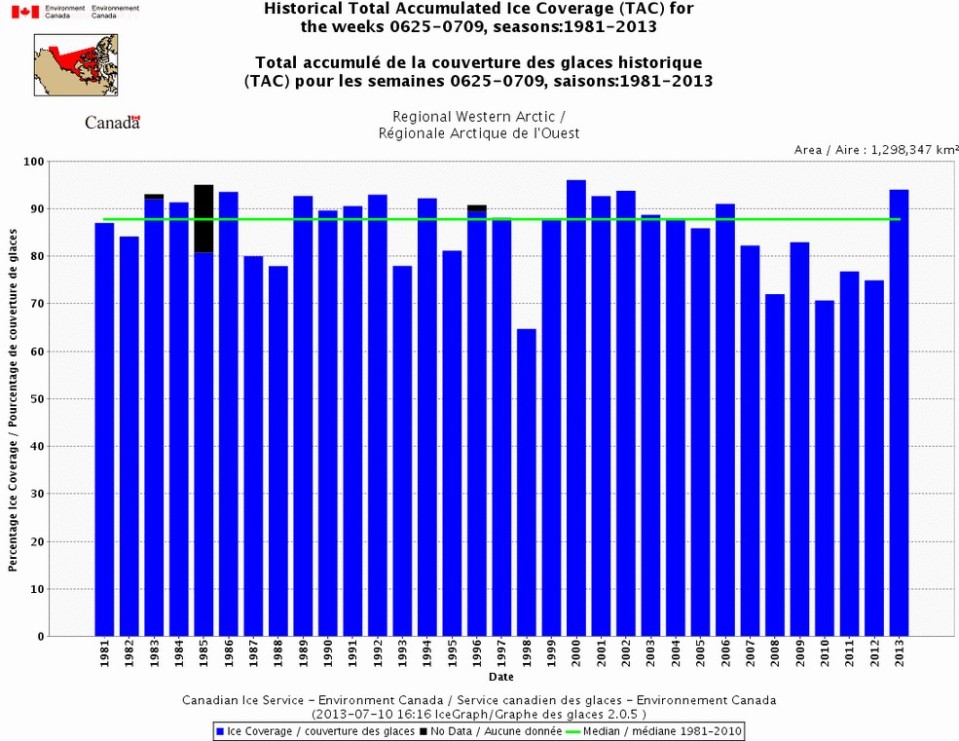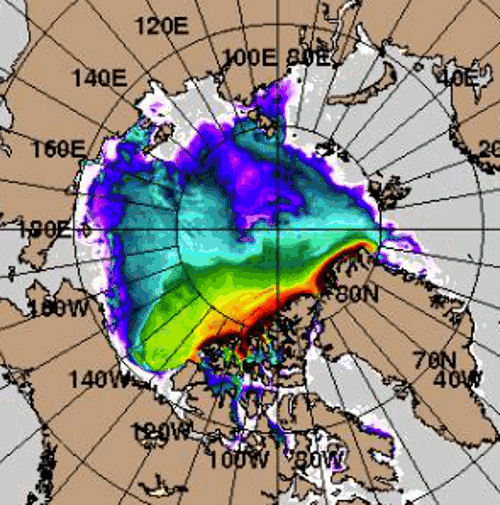The team of four men rowing in the Arctic has run into headwinds. Literally. They originally talked about making 100 kilometers on a good day (62 miles), and 40 kilometers on an average day. Two weeks into the voyage, it was clear that things weren’t going according to plan. And sometime in September, the melt season ends and ice begins building up quickly. Their total journey was expected to last until mid to late September.
A few days ago, I wondered how they were doing and was growing tired of doing the math in my head repeatedly. And as I’d recently discovered that their old position indicators are removed after a week, I set up a little spreadsheet to keep track. It was easy enough to track rates of speed, and ultimately project when they would finish the route based upon their average speed so far. Here’s what I came up with — click on the small chart to enlarge it:


I didn’t want to post this before, as I wanted to give the fellows a shot at recovering from their very bad first week. But progress since then has been steady, if slow, and my projection of their finish date (currently after Thanksgiving!) is not getting better. There has been only one day when they exceeded their intended average (hitting a bit over 47km in a 24-hour period) and their net for the trip is half of that, and dropping.
Their current blog post is one of putting a brave face on a grim situation:
My last shift with Denis consisted of zero rowing. We started rowing but were making no progress due to the stiff headwinds so we spent three and half hours pushing the boat through the shallow water – we made 5.5 km in four hours. If we had calm conditions, we could row this in one hour with far less effort.
It’s unfortunate that “stiff headwinds” means anything of 15kts or better, since the nearly eight-meter (25ft) craft has a large surface area and only two rowers at a time.
And these winds are mild, compared to what might be expected in the Arctic. They seem to say that they knew this (they’ve read a lot of Arctic history, and took those books with them). But they hoped for better, or that the winds would be behind them.
I think that even last year, when an unusual storm produced a large Arctic melt, they’d have still had a hard time. The current slow progress has been even before they’ve gotten into ice-enforced slowdowns, and it seems likely that they will skid to a halt soon.
===|==============/ Keith DeHavelle
The MainstreamLastFirst rowers got stuck for a while, backtracking a bit over their previous path before shutting off their position transmitter again. About 28 hours later, they’ve turned it back on … for one ping only. They’ve made about 12 kilometers in the intervening period, but they are hoping for 40km per day average and 100km on good days in order to meet their goals.
So far, in ten days they’ve covered 180km in linear distance (it will be somewhat more in reality as they’ve not traveled in a straight line). But this is still less than half of the average speed they’d hoped to make.
Their position transmitter is set up to send their coordinates ten minutes. Early in the voyage, it was doing that — even on the drive from Vancouver to Inuvik. But there have been days where nothing is seen of their position on the map, including yesterday up until a few hours ago. And, after a single ping, they have shut it off again. But in that one point, the map shows that they are heading up a very narrow inland channel … and appear to be running out of waterway:


I am guessing that they will have to backtrack all the way out, and go around on the windward side. Interestingly, they’ve got computers and Internet on board, and they can examine this course as well as I can, in addition to comparing it with what they see around them. Despite this, they’ve made at least one similar mistake already, and their course shows two times where they’ve backtracked. One was admittedly a wrong guess as to the passability of the inland course.
I understand the motivation. On the windward side, they’re fighting the large “sail area” of their 25-foot (almost 8-meter) rowboat, with only two men able to row at a time. Anything that gets them out of the wind, and the rougher seas, must look very attractive.
But if it doesn’t go through, it’s a heartbreaking waste of time. And they cannot afford such mistakes. Perhaps they’ve turned off their transponder while they go back, and will turn it back on once they’ve gone far enough forward to make the reverse course invisible. (The GPS merely draws straight lines between pings.) If so, it’s good PR … but not particularly true to the spirit of “follow along with us every ten minutes” that they bragged about. This is frustrating to one follower, especially since the team is demonstrating that they are still on the Internet. They replied just an hour ago:


Now, they’re in the boat, and they were asked if it was “ice, wind or whatever” — and they evidently don’t know. It’s about midnight there now, but the sun is still up and their plan was to row 24 hours a day. And they have windows in the little cabin. So they are intentionally being unhelpful here, which has its own suggestions.
I’ll bet they’ve had to (or will have to) turn around, and they know it. It’s not an unpardonable sin, but it is a costly mistake both in terms of muscle and spirit.
You can follow along to the extent they allow at their tracking page here. Or their Facebook page here.
===|==============/ Keith DeHavelle




I’ve been following (for a few weeks now) an adventure in the Arctic Ocean that I have mixed feelings about. The plan is to traverse (most of? NOT) the Northwest Passage under human power alone, in a specially designed rowboat. Four men, seasoned adventurers sponsored by a European renewable energy company, intended to row 24 hours a day, in pairs of rowers on 4-hour shifts, to demonstrate that the ice melt is so dramatic that it is now possible to do this. The mixed feelings come from:
- My appreciation for the spirit of adventure and daring, and the training and effort that have gone into this attempt.
- My annoyance at yet another “climate change” propaganda piece. The goal is to demonstrate how devastated the Arctic ice is by global warming.
One of the many bits of cleverness about the journey is its social connection; there is a GPS tracking system broadcasting their location every ten minutes. Here is (roughly) their planned route:

They planned to launch their 25-foot craft July 1st. Ice and other things did not cooperate, and they were several days late. But you could follow their trek from Vancouver to Inuvik on Canada’s north coast (not too far from Alaska) as they rolled up the highway. They arrived in good order, were somewhat late getting in the water, and set out on July 5th. Previously, they’d anticipated making 100km per day on good days (62 miles) and averaging 40km per day overall.
So far, that hasn’t worked out. They made it out of the MacKenzie River, but were still in the delta area, when they were stalled by storms and high winds. July 8 found them attempting to sneak through an inland passage, only to have to turn back when it had no exit to open water. They fell back a couple of kilometers, but within sight of Tuktoyaktuk about 7km away, and there they sat for about three days.
Their Facebook and blog postings described high winds (gale force) and rough, stormy seas — and frustration that they could actually see the tiny town that was their next waypoint, but could not get there.
But here is where things start to get strange. That next stop, only about 5 miles away, had a weather station. It was reporting 10-15 miles per hour winds (and sometimes as little as 8 to 11mph) while they were reporting “gales.” Moreover, their own pictures of pulling the boat by hand, and cooking on shore, showed relatively calm seas: The fire they lit would not have worked in high winds:

Look at the water in the background below. That, plus the appearance of the fire, hardly seems to jive with the winds they reported at the time.

Here’s where they were camped, on a little spit of low land in this bay. You can see the track of their misadventure trying to get through on the inland side:


The weather they reported was at considerable odds from that reported by the official weather station only five miles away — in a town they could see from where they were camped for three days:


I’d been watching it, and saw no reading higher than 15mph.
Today, they posted, they’ve finally arrived in Tuktoyaktuk. Still describing a haul through heavy winds (while the weather station at the little town was reporting 10-15mph), they did not touch base there and move on — they stopped. During this time, they did not turn their GPS tracker back on — it still shows them camped out in the little bay 7km back. The photo they took today of their Arctic Joule at the shoreline again shows calm seas. They have a lot of catching up to do, and dawdling at this little town isn’t going to get them there. Some Facebook fans noted that they hadn’t been transmitting their GPS signal:

And in the little seacoast town, once again the ocean seems calm.


Last year’s very low ice was triggered by a large cyclone (in August) breaking up the ice, allowing it to both melt more rapidly and be pushed out through the exit channels. This year, however, the ice level is quite high at this point. One chart shows current Western Arctic ice as the third highest on record (but of course, these “records” only go back a short time). Hat tip to Steve Goddard, who has been following (and posting on) this process and keeping up with the weather and other doings there:


The fellows are having a rough go of it, and this seems likely to continue. And it seems to me that they’ve been overstating the weather difficulties. But I suspect that part of the issue here is that even a modest headwind on that rather large boat is proving to be much more of a challenge than they anticipated.
UPDATE: They’ve just pulled out again, heading north. Good for them. I approve of their effort and resolve, but not of the propaganda use being made of it. And they have willingly participated in that, in order to fund the trip and garner other support. No doubt they are True Believers, but they are making judgment errors when bumping against reality.
Prediction: They will not complete the planned trip, but (1) this will be counted a success anyway, and (2) the failure will be blamed on “extreme weather” caused by “climate change.”
===|==============/ Keith DeHavelle


No comments:
Post a Comment
Enter your comment(s) here...